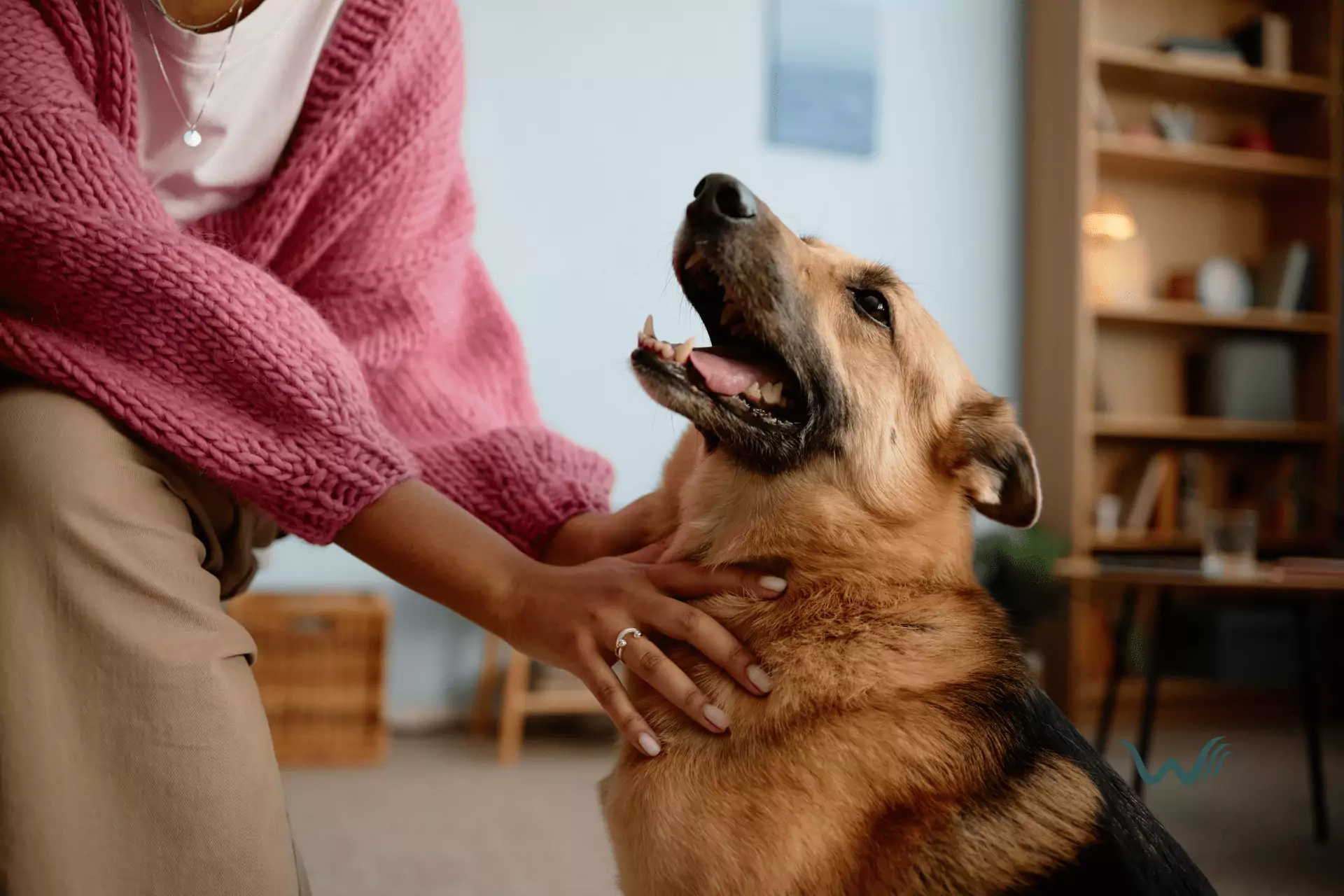

Exploring Hypoallergenic Dog Breeds
by Haley Mills
Last updated: July 15, 2024
Verified and Approved by:
Angela Morris,
MSW, LCSW
Fact Checked

Are you an animal lover with a pesky allergy that keeps you from enjoying the company of a furry friend? Well, fear not! In this article, we will explore the wonderful world of hypoallergenic dog breeds.
These breeds are specifically bred to be more compatible with individuals who suffer from allergies, making it possible for you to finally experience the joy of having a dog without the sneezing, itching, and watery eyes.
Imagine being able to snuggle up with a dog without having to worry about your allergies acting up. Hypoallergenic dog breeds are the answer to your prayers. These breeds produce fewer allergens, such as dander, saliva, and urine, which are the main culprits behind allergic reactions.
By understanding the characteristics and traits of these hypoallergenic dogs, you can find the perfect match for your lifestyle and allergy needs. So, get ready to embark on an exciting journey as we delve into the world of hypoallergenic dog breeds and discover which one might be the best fit for you.
Key Takeaways
- Hypoallergenic dog breeds produce fewer allergens such as dander, saliva, and urine.
- They have hair instead of fur and do not shed as much, resulting in fewer allergens in the air.
- Regular grooming, including brushing, bathing, cleaning ears, and trimming nails, is important for hypoallergenic dogs.
- Keeping the home clean, using a HEPA air purifier, and minimizing exposure in certain areas can help manage allergies when caring for a hypoallergenic dog.
Understanding Hypoallergenic Dog Breeds
If you or someone you know suffers from allergies, you understand how frustrating it can be to constantly deal with sneezing, itching, and watery eyes. But fear not, because hypoallergenic dog breeds might just be the solution you’ve been looking for!
These breeds are known for producing fewer allergens, which means they are less likely to trigger allergic reactions in sensitive individuals.
Now, you might be wondering how exactly hypoallergenic dog breeds achieve this feat. Well, it all comes down to their hair or lack thereof.
Unlike other dogs, hypoallergenic breeds have hair instead of fur, which makes a world of difference for allergy sufferers. This hair grows continuously, much like human hair, and doesn’t shed as much as fur does.
As a result, there are fewer allergens floating around in the air and sticking to your furniture and clothes. So, if you’re tired of constantly having to vacuum and lint roll everything in sight, a hypoallergenic dog breed might be the perfect choice for you.
By choosing a hypoallergenic dog breed, not only will you be able to enjoy the company of a furry friend, but you’ll also be serving your own needs. These breeds have been specifically bred to be more compatible with people who have allergies, so you can rest assured that you’re making a conscious decision to prioritize your health and well-being.
Plus, let’s not forget the joy and happiness that a dog can bring into your life. So, go ahead and explore the world of hypoallergenic dog breeds – your allergies will thank you!
Common Allergens and Their Effects on Allergic Individuals
Allergens can come from various sources, such as pollen, dust mites, pet dander, and mold spores. These tiny particles can trigger allergic reactions, causing symptoms like sneezing, itching, watery eyes, and even difficulty breathing.
For individuals with allergies, it can feel like their body is constantly under attack, and they must navigate through a minefield of potential triggers.
Even though allergens may seem harmless to some, they can cause great discomfort and distress to those who are allergic. It’s crucial to be aware of common allergens and take steps to minimize exposure. By doing so, you can create a safer and more comfortable environment for those who are sensitive to these allergens.
Whether it’s keeping a clean and dust-free living space, avoiding contact with certain plants during allergy season, or choosing hypoallergenic dog breeds, your efforts can make a significant difference in the lives of allergic individuals.
Characteristics of Hypoallergenic Dog Breeds
To understand the characteristics of hypoallergenic dog breeds, you’ll need to consider their coat type and shedding patterns. Hypoallergenic dogs are known for producing fewer allergens, which can be a relief for individuals with allergies. One key factor to consider is the type of coat that these breeds have. Most hypoallergenic dogs have hair-like coats instead of fur, which reduces the amount of dander they produce. Dander is a common allergen that can trigger allergic reactions in sensitive individuals. Additionally, hypoallergenic dog breeds tend to have minimal shedding, which means there is less hair and dander being released into the environment.
To give you a better idea of some hypoallergenic dog breeds and their characteristics, let’s take a look at the table below:
| Breed Name | Coat Type | Shedding Level |
|---|---|---|
| Poodle | Hair-like | Minimal |
| Bichon Frise | Hair-like | Minimal |
| Maltese | Hair-like | Minimal |
As you can see, all three breeds listed have hair-like coats and minimal shedding. This makes them great options for individuals with allergies. Not only do these breeds produce less dander, but their minimal shedding also means less hair to clean up around the house. So, if you’re looking for a hypoallergenic dog breed, consider these characteristics to make an informed decision that suits both your allergies and your desire to serve others.
Tips for Choosing the Right Hypoallergenic Dog Breed for You
With countless options available, finding the perfect hypoallergenic furry companion can be an overwhelming task. But fear not, for here are some tips to help you choose the right hypoallergenic dog breed for you.
Firstly, consider your lifestyle and living situation. Are you an active person who enjoys long walks and outdoor activities? Then a breed like a Bichon Frise or a Portuguese Water Dog might be a good fit for you. These breeds are energetic and love to be outdoors. On the other hand, if you prefer a more low-key lifestyle, a breed like a Maltese or a Shih Tzu might be more suitable. These breeds are known for their calm and laid-back nature.
Secondly, think about the size of the dog. Do you live in a spacious house with a large backyard, or do you live in a small apartment? If you have limited space, a smaller hypoallergenic breed like a Yorkshire Terrier or a Havanese might be a better choice. These breeds are small in size and don’t require as much space to move around. However, if you have plenty of room to spare, you can consider a larger hypoallergenic breed like a Standard Poodle or a Giant Schnauzer.
By considering your lifestyle, living situation, and the size of the dog, you can narrow down your options and find the perfect hypoallergenic dog breed for you. Remember to choose a breed that fits your lifestyle and that you can provide the care and attention it deserves. With a little bit of research and consideration, you’ll be well on your way to finding the perfect hypoallergenic furry companion that will bring you joy and happiness for years to come.
Caring for Hypoallergenic Dogs: Maintenance and Allergy Management
To properly care for a hypoallergenic dog, you’ll want to establish a regular grooming routine to keep their fur clean and free of allergens. This is an important part of allergy management as it helps to reduce the amount of dander and other allergens that may be present on your dog’s coat.
Regular brushing is key, as it helps to remove any loose hair and dead skin cells that can contribute to allergies. You’ll also want to give your dog regular baths using a hypoallergenic shampoo that’s specifically formulated for dogs with allergies. This will help to keep their skin clean and free of irritants. Additionally, regularly clean your dog’s ears and trim their nails to prevent any potential infections or discomfort.
In addition to grooming, there are other steps you can take to manage allergies when caring for a hypoallergenic dog. Keep your home clean and free of allergens by regularly vacuuming, dusting, and washing your dog’s bedding. You may also want to consider using a HEPA air purifier to help filter out any allergens in the air.
It’s also a good idea to keep your dog out of certain areas of your home, such as your bedroom, to minimize exposure to allergens. Lastly, it’s essential to pay attention to your own allergies and take any necessary precautions, such as washing your hands after handling your dog and avoiding close contact if you have a severe allergy.
Frequently Asked Questions
Are all hypoallergenic dog breeds completely hypoallergenic, meaning they won’t cause any allergic reactions in individuals with allergies?
Not all hypoallergenic dog breeds are 100% allergy-free. While they may be less likely to cause allergic reactions, it’s important to remember that every individual is unique and may still have some level of sensitivity.
Can hypoallergenic dog breeds still shed their fur, and if so, how can this be managed to reduce allergens in the environment?
Hypoallergenic dog breeds can still shed their fur, but there are ways to manage it and reduce allergens. Regular grooming, vacuuming, and washing bedding can help keep allergens at bay, allowing you to serve others without worrying about allergies.
How do hypoallergenic dog breeds compare in terms of exercise needs and energy levels?
When it comes to exercise needs and energy levels, hypoallergenic dog breeds vary. Some are more laid-back, preferring leisurely walks, while others have boundless energy and require plenty of playtime.
Are there any specific grooming requirements for hypoallergenic dog breeds, and if so, what are they?
Are you wondering about the grooming needs of hypoallergenic dog breeds? Well, these breeds require regular grooming to keep their fur clean and tangle-free. Regular brushing, occasional haircuts, and frequent baths are essential for their hypoallergenic qualities.
Can hypoallergenic dog breeds be trained to be therapy dogs or service dogs?
Can hypoallergenic dog breeds be trained to serve as therapy or service dogs? Absolutely! These furry companions possess the intelligence and gentle nature necessary for such noble roles. They are ready to bring comfort and assistance to those in need.
Certify Your Emotional Support Animal Today

Why You Can Rely on Us?
At Wellness Wag, we believe your pet deserves care rooted in both science and compassion. Each article is carefully researched, written in clear language for pet owners, and then reviewed by qualified professionals to ensure the information is evidence-based, current, and practical for real-life care. Our goal is to help you feel confident in making informed decisions about your pet’s health and well-being.
Reviewed by
Angela Morris, MSW, LCSW
Angela is a licensed clinical social worker with 20 years of experience in patient advocacy and community mental health. She has assisted numerous clients with ESA evaluations and brings a deep understanding of disability accommodations, ensuring that all information is accurate, supportive, and practical.

Written by :
Haley Mills
Last Updated :
July 15, 2024











